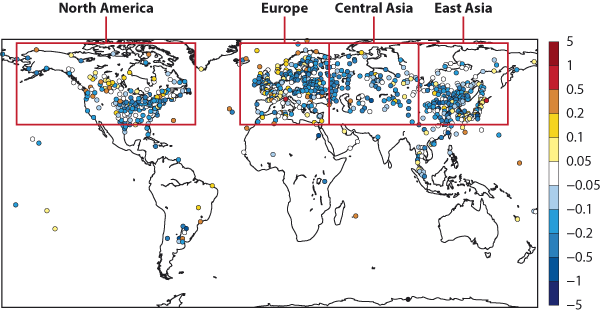

A study published on 17 October 2010 in the journal Nature Geoscience shows that over the past three decades, surface wind speeds seem to have noticeably decreased in several regions of the world, such as the United States, China, Australia, and in several European countries. Given the often inadequate quality and heterogeneity of wind data measured by anemometers, no long-term study of the evolution of wind speeds on a global scale had been carried out so far.
However, after a detailed and thorough statistical analysis of the inconsistencies of wind measurements taken at 5412 stations resulting in the rejection of 85 % of them, an analysis of the remaining data revealed a major trend: over most land surfaces of the Northern hemisphere mid latitudes, winds have decreased (see figure below). The study was carried out jointly by the Laboratoire des Sciences du Climat et de l'Environnement (LSCE) and the European Centre for Medium-Range Weather Forecasts (ECMWF). It also shows that over Asia, moderate to strong winds have decreased most rapidly.
This study also attempts an explanation of the reasons for this decrease. Using a variety of data (datasets from reanalyses carried out by ECMWF or other smaller scale simulations, satellite and radiosonde observations), the authors show that this decrease in surface wind speed can be largely explained by an increase in vegetation and, to a smaller extent, by changes in the general atmospheric circulation over the past few decades.
The study does not allow direct conclusions about the possible consequences of such a decrease on the potential of wind power, because wind energy is generated at a higher level (50m - 100m) than the level at which the wind measurements are taken. This issue is currently being examined.

Distributions of surface level wind tendencies between 1979 and 2008 (m/s/decade)
Reference: Vautard, R., Cattiaux, J., Yiou, P., Thépaut, J.-N. & Ciais, P. Nature Geosci. advance online publication doi:10.1038/NGEO979 (2010)
